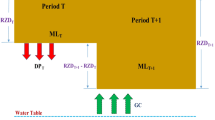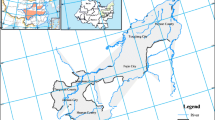Abstract
A linear programming (LP) based optimization model and a simulation model are developed and applied in a typical diversion type irrigation system for land and water allocation during the dry season. Optimum cropping patterns for different management strategies are obtained by the LP model for different irrigation efficiencies and water availability scenarios. The simulation model yields the risk-related irrigation system performance measures (i.e. reliability, resiliency and vulnerability) for the management policies defined by the optimization model. The alternative strategies are evaluated in terms of all performance criteria (i.e. net economic benefit, equity and reliability) simultaneously through a trade-off analysis using a multi-criteria decision making method (compromise programming). For the case study of the Kankai irrigation system in Nepal, with equal preference to the objectives, a management strategy with equal share of water among the project subareas appears to be the most satisfactory alternative under water shortage conditions. The existing water allocation policy is not economically efficient. Deficit irrigation in Early paddy appears attractive under favorable hydrologic scenario, particularly if accompanied by measures to improve existing irrigation system efficiency.
Similar content being viewed by others
References
Angeles L.H. & Hill R.W. 1985. Efficient water use in run-of-the-river irrigation.Journal of Irrigation and Drainage Engineering ASCE 112(2): 147–159.
Banskota M.P. (1993).Dry season irrigation planning under multiple criteria: The case of Kankai Irrigation Project, Nepal. Masters thesis (Unpublished), 101pp. Asian Institute of Technology, Bangkok, Thailand.
Bos M.G. & Nugteren, N. 1978.On Irrigation Efficiencies. Publication 19, 2nd Edition. International Institute for Land Reclamation and Improvement/ILRI, Netherlands.
Chavez-Morales J., Marino M.A. & Holzapfel E.A. 1992. Planning simulation model of irrigation district.Journal of Irrigation and Drainage Engineering ASCE 118(1): 74–87.
Doorenbos J. & Kassam A.H. 1979.Yield response to water. Irrigation and Drainage paper 33. FAO, Rome
Doorenbos J. & Pruitt W.O. 1977.Guidelines for prediction of crop water requirements. Irrigation and Drainage paper 24. FAO, Rome.
Dudley N.J., Howell D.T. & Musgrave W.P. 1971. Optimal intraseasonal irrigation water allocation.Water Resources Research 7(4): 770–788.
Gershon M. & Duckstein L. 1983. Multiobjective approaches to river basin planning.Journal of Water Resources Planning and Management ASCE 109(1): 13–28.
Hashimoto T., Stedinger J.R. & Loucks D.P. 1982. Reliability, resiliency and vulnerability criteria for water resources system performance evaluation.Water Resources Research 18(1): 14–20.
Hiessl H. 1987. Risk aspects in the determination of optimal cropping pattern. In: L. Duckstein and E.J. Plate (Ed)Engineering Reliability and Risk in Water Resources, (pp 485–498). Martinus Nijhoff Publishers, Boston.
Lakshminarayana V. & Rajagopalan S.P. 1977. Optimal cropping pattern for basin in India.Journal of Irrigation and Drainage Division, ASCE 103(IRI): 53–70.
MacDonald Agricultural Service Ltd & East Consult (P) Ltd, Nepal. 1990. Design manuals for irrigation projects in Nepal, M.3.Hydrology and Agro-meteorology Manual. Planning Design and Strengthening Project. Department of Irrigation, Nepal.
Ng P-K. 1988. Irrigation Systems Performance monitoring and evaluation: reliability, resiliency, and vulnerability criteria for assessing the impact of water shortage on rice yield.IIMI Review 2(1): 12–16.
Onta P.R., Dasgupta A. & Paudyal G.N. 1991. Integrated irrigation development planning by multiobjective optimization.International Journal of Water resources Development 7(2): 185–193.
Phien H.N. & Ruksasilp W. 1981. A review of single site models for monthly streamflow generation.Journal of Hydrology (52): 1–12.
Raman H., Mohan S. & Rangacharya N.C.V. 1992. Decision support for crop planning during droughts.Journal of Irrigation and Drainage Engineering ASCE 118(2): 229–241.
Sampath R.K. 1988. Equity measures for irrigation performance evaluation.Water International 13(1): 25–32.
Small L.E. & Svendsen M. 1990.A framework for assessing irrigation performance. Irrigation and Drainage Systems (4): 283–312.
Tsakiris G.P. 1982. A method for applying crop sensitivity factors in irrigation scheduling.Agricultural Water Management 5: 335–343.
Zeleny M. 1982.Multiple criteria decision making. McGraw-Hill, New York.
Author information
Authors and Affiliations
Rights and permissions
About this article
Cite this article
Onta, P.R., Loof, R. & Banskota, M. Performance based irrigation planning under water shortage. Irrig Drainage Syst 9, 143–162 (1995). https://doi.org/10.1007/BF00881673
Accepted:
Issue Date:
DOI: https://doi.org/10.1007/BF00881673




